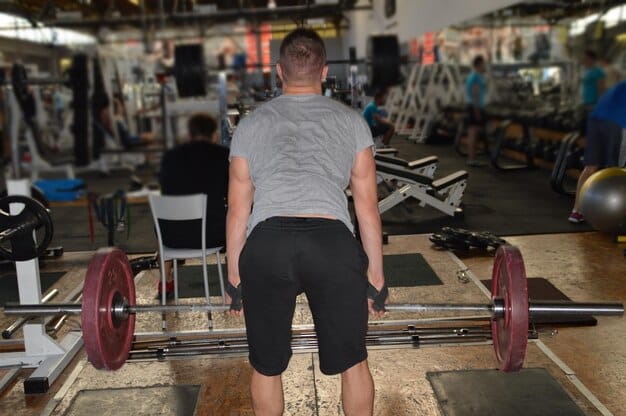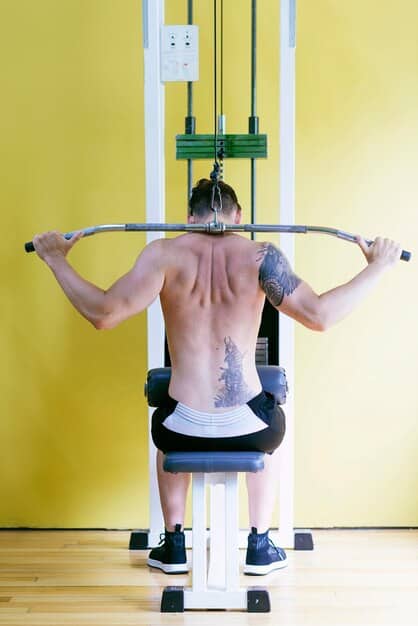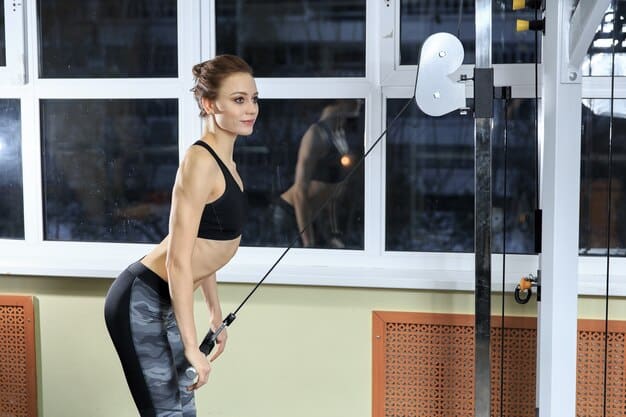Build a Stronger Back: Rows and Pull-Downs Guide

Build a stronger back with our ultimate guide to rows and pull-downs, detailing proper form, variations, and workout strategies to enhance your fitness routine and achieve optimal results in your back training.
Unlock the secrets to a powerful and resilient posterior chain with the ultimate guide to rows and pull-downs. This comprehensive article will equip you with the knowledge needed to build a stronger back, improve your posture, and enhance your overall fitness journey.
The Anatomy of a Strong Back
Embarking on a journey to strengthen your back requires an understanding of the muscles involved. The back is not just one muscle group; it’s an intricate network working in concert to provide support, stability, and movement.
Key Muscle Groups
Several muscles contribute to a strong and functional back. These muscles play distinct roles, and knowing them will help you target them effectively during your workouts.
- Latissimus Dorsi: Commonly known as the “lats,” these are the broadest muscles in your back, responsible for adduction, extension, and internal rotation of the arm.
- Trapezius: The traps extend from the base of your skull to the mid-back and laterally to the shoulder blades, controlling scapular movement.
- Rhomboids: Located beneath the traps, the rhomboids retract and elevate the shoulder blades.
- Erector Spinae: These muscles run along the spine, providing spinal extension and rotation.
Understanding these muscle groups allows you to craft a well-rounded back workout. Targeting these muscles with exercises like rows and pull-downs helps create a balanced and strong physique.
By focusing on each muscle group through varied exercises, you’ll increase overall back strength, improve posture, and reduce the risk of injuries. This approach ensures comprehensive development and functional fitness.
Mastering the Row: Form and Variations
Rows are foundational exercises for building back strength. Proper form is crucial to avoid injuries and maximize muscle activation. Understanding different row variations allows you to target specific areas of the back.
Proper Rowing Form
Maintaining correct posture and movement patterns is paramount. Start with a solid base and focus on controlled movements to engage the right muscles effectively. Whether using barbells, dumbbells, or machines, the fundamentals remain constant.

- Neutral Spine: Keep your back straight and avoid rounding or arching.
- Engage the Core: A strong core provides stability and support during the exercise.
- Controlled Movement: Pull with your back muscles, not your arms, and control the weight as you lower it.
- Full Range of Motion: Extend fully at the bottom and contract completely at the peak of the movement.
Row Variations
Different row variations target different areas of the back. Incorporating a variety ensures balanced muscle development and prevents plateaus in your strength gains.
Switching up your row variations can also help keep your workouts interesting and challenging. It can also target muscles from different angles helping you to develop a more complete back.
Barbell rows are great for overall back strength, while dumbbell rows can help address muscle imbalances. Cable rows are good for constant tension, and chest-supported rows minimize lower back strain.
By mastering the row with perfect form you can have a stronger, healthier back for everyday life.
Pull-Downs: Building Width and Strength
Pull-downs are excellent exercises for building upper back width and strength. These exercises primarily target the lats, helping to create the coveted V-taper look.
Technique for Perfect Pull-Downs
Using proper technique for perfect pull-downs involves controlled movements, proper grip, and a focus on engaging the lat muscles.
- Grip Width: A slightly wider than shoulder-width grip is generally recommended.
- Controlled Descent: Lower the bar slowly, focusing on engaging the lats.
- Chest Position: Bring the bar down towards your upper chest, maintaining a slight lean back.
- Squeeze and Control: Squeeze your shoulder blades together at the bottom of the movement and control the ascent.
Pull-Down Variations
Pull-down exercises come in various forms. Just as the different row variations work muscles in different areas of the back, pull-down variations have different attributes for the workout.
Wide-grip pull-downs emphasize the outer lats, close-grip pull-downs engage the lower lats, and underhand grip pull-downs recruit the biceps more. Each variation offers a unique challenge and benefit.
Experiment with different variations to find the ones that work best for you and align with your fitness goals. Consider combining these variations into a comprehensive back workout routine.
Integrating Rows and Pull-Downs into Your Workout
Effectively integrating rows and pull-downs into your workout requires a strategic approach. Combining these exercises can lead to synergistic gains in back strength and muscle development.

Sample Workout Routine
Here’s a sample workout routine that effectively combines rows and pull-downs, including reps and sets. Remember to adjust the weights to challenge yourself while maintaining good form.
Don’t begin immediately with these workout examples. Ensure you warm-up and stretch before moving to weightlifting or weight training.
- Barbell Rows: 3 sets of 8-12 reps
- Lat Pull-Downs: 3 sets of 10-15 reps
- Dumbbell Rows: 3 sets of 10-15 reps per arm
- Close-Grip Pull-Downs: 3 sets of 12-15 reps
Adjust volume and intensity based on your fitness level and goals. Focus on progressive overload, gradually increasing the weight, reps, or sets as you get stronger.
Progressive Overload and Progression
Progressive overload is a key principle in strength training. Regularly challenging your muscles with increased demands leads to continued growth and strength gains.
Increase the weight you lift, the number of repetitions you perform, or the number of sets you complete over time. Small, gradual increases are more sustainable and less likely to result in injury.
Also, if you increase the weight you lift you may need to decrease the number of repetitions. The same can apply for sets. Experiment with what works best for the individual.
By systematically applying progressive overload, you ensure continuous progress and prevent plateaus in your back training journey.
Common Mistakes to Avoid
Avoiding common mistakes can prevent injuries and ensure you’re getting the most out of your back workouts. Awareness and attention to detail can make a significant difference in your results.
Poor Form
Using incorrect form can lead to muscle imbalances, strains, and more serious injuries. Priority must be given to technique at all times.
- Rounding the Back: Maintain a neutral spine to protect your lower back during rows.
- Using Momentum: Avoid using momentum to swing the weight; focus on controlled muscle contractions.
- Overextending: Do not overextend at the top of the movement, as this can strain your shoulder joints.
Neglecting the Scapula
The scapula (shoulder blade) plays a crucial role in back exercises. Neglecting to engage and control the scapula can limit muscle activation and increase the risk of injury.
Focus on protracting (moving forward), retracting (squeezing back), elevating (shrugging up), and depressing (pulling down) the scapula in all exercises. This ensures comprehensive muscle engagement.
Engaging the scapula improves mind-muscle connection, enhancing the effectiveness of each repetition. By mind-muscle connection, you connect with the movements your muscles make, almost to the point you can mentally direct them.
If necessary, seek input from a qualified trainer to ensure proper form and scapular engagement. Their expertise can help correct any imbalances or technique flaws.
Nutrition and Recovery
Nutrition and recovery are pivotal components in building a strong back. A well-balanced diet and adequate rest can significantly enhance your training results.
The Role of Protein
Protein is essential for muscle repair and growth. Ensuring you consume enough protein can optimize your body’s ability to recover and build stronger back muscles.
Aim for 0.8 to 1 gram of protein per pound of body weight. Include protein-rich foods like lean meats, fish, eggs, dairy, and plant-based sources such as legumes and tofu in your diet.
Protein supplements, such as whey or casein, can also be beneficial, particularly post-workout. These supplements provide a quick and convenient source of amino acids to support muscle recovery.
Importance of Rest
Rest is just as important as exercise. Your muscles grow and repair during periods of rest, so neglecting rest can hinder your progress and increase the risk of overtraining. Ensure you are getting enough rest by focusing on diet and sleep.
Get 7-9 hours of quality sleep per night to allow your body to fully recover. Incorporate active recovery days with light activities like walking or stretching to improve blood flow and reduce muscle soreness.
Listen to your body and take rest days when needed. Overtraining can lead to fatigue, decreased performance, and a higher risk of injury. Proper balance is key for long-term success.
| Key Point | Brief Description |
|---|---|
| 💪 Proper Form | Maintain neutral spine and engage core during rows and pull-downs. |
| 🔄 Variation | Incorporate different row and pull-down variations for balanced muscle development. |
| 📈 Progressive Overload | Increase weight, reps, or sets to continually challenge muscles. |
| 🍽️ Nutrition & Rest | Consume enough protein and get ample sleep for muscle recovery and growth. |
Frequently Asked Questions
▼
For muscle building, aim for 8-12 reps per set. This range typically provides the best balance of mechanical tension and metabolic stress, both of which are essential for hypertrophy, or muscle growth.
▼
Train your back 2-3 times per week, allowing at least 48 hours of rest between sessions. This frequency ensures adequate recovery while still providing sufficient stimulus for muscle growth and strength gains.
▼
Both are highly effective, targeting different muscles. Rows build thickness, while pull-downs build width. Incorporating both into your routine ensures comprehensive back development and is recommended.
▼
Yes, you can perform rows and pull-downs in the same workout. Just be sure to balance the volume and intensity and allow for adequate recovery between sets. Alternate the exercises.
▼
Signs of overtraining include persistent muscle soreness, decreased performance, fatigue, and difficulty sleeping. If you experience these, reduce your training volume and prioritize rest and recovery immediately.
Conclusion
Incorporating rows and pull-downs strategically into your fitness regimen allows you to create a stronger, and healthier, back. By understanding the back’s anatomy, training variations, and recovery strategies, you are setting yourself up for success.





